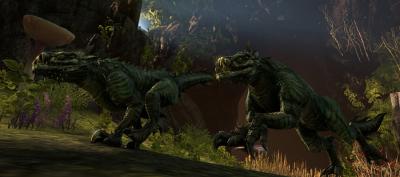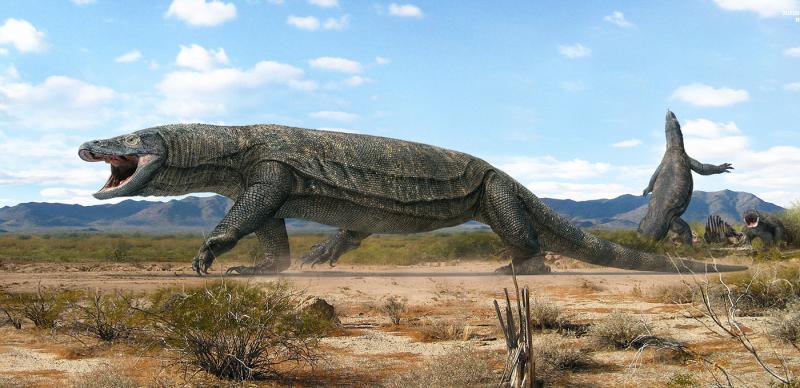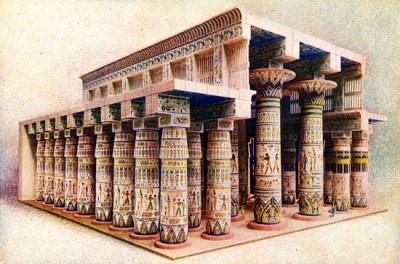In its current form the Ancient Lands consist of 16 that are described in some detail. They only cover about 10% of the map of the region but are home the the majority of the population. Each region can be seen as an individual mini-setting in a way, but unlike a considerable number of kitchen sink settings they are not made in a vacuum. Most tribes are found in more than just one region and they are all deeply connected by culture and trade, even if they are separated by hundreds of miles of trackless wilderness or open sea. The goal for each region is to provide a strong cultural environment as well as a template for landscapes and wildlives, including several example settlements and adventuring sites that help estabish the tone of the region and can also be put directly into an adventure. But in the end, most settlements in the Ancient Lands are highly independent and connected to their immediate neighbors, with only few major cultural or political centers. With the regions being mostly defined by themes and culture instead of specific centers of power where all the important things are happening, it would be futile to attempt to cover everything, and also pointless.
Which each region I want to provide a few ideas for adventure hooks and also campaign structure that give a good impression what they are for and how they are meant to be used. In effect, the regions of the Ancient Lands are structured more like planets in Space Opera games like Star Wars or Stars Without Number, and less like a campaign sourcebook for Dungeons & Dragons. The following are the ideas as I currently have them:
Venlad
Venlad is the distant northern land of the Mari who catch fish and hunt seals and whales on the coasts and herd reindeer on the tundra. Most visitors are traders who come to the few larger ports to trade goods from the south for pelts, dried fish, whalebone, and walrus tusks.
I want to do something with the spirits of winter and cold, but no clear idea for adventure hooks yet.
Yakun
This is the homeland of the kaas, a race of tall and strong beastmen. It consists of large subarctic forests and is surrounded by steep mountains and jagged hills. There are also some town and fortresses of skeyn and Keyren on the southern borders of this land.
I also don’t have any specifics for the main plot hooks yet, other than kaas clans getting into wars with each other.
Witchfens
The Witchfens are a large moor south of Yakun and west of Revand. There are a few rocky hills and small clusters of birches in a few places, but mostly it’s just and endless land of shrubs and bogs, prone to frequent rain and often covered by fog. Only the Kaska make their homes in this dreary land, as they believe something below the waters is keeping away the angry spirits that have sworn eternal revenge against them for a terrible blasphemy in the past.
Trailing Raiders: The Kaska are very poor people and barely get by surviving in this land by hunting and growing a few meager crops. Bands of raiders often sneak into Revand and Yakun to get whatever weapons, food, cloth, and slaves they can before returning swiftly into the fens. Only the bravest heroes dare following them into the thick fogs to rescue prisoners or retrieve stolen relics.
Spirits of the Fens: The Witchfens are a strange land inhabited by even stranger spirits. Many believe the dark pools that dot the landscape to lead to the Underworld and that there are many demons mingling with the spirits. The clans of the Kaska have made pacts with these dark spirits to protect them from the wrath of their old gods, but even they don’t know exactly what powers they are dealing with.
Revand
Revand is a stretch of coast north of the Tavir Mountains, sparsely inhabited by the descendants of the Keyren who didn’t leave for the islands of Halond to the east. The land lies in the shadow of the mountains in more than one sense, as they are almost permanently shrouded by a misty haze that obscures the sun even on a clear day. Strange creatures are often found in the great rivers that come down from the mountains and few people live far from the coast where the forest are lightest and a steady breeze from the sea keeps the air clean. The deeper one travels into the forest, the darker and gloomier they get, and dangerous creatures can be found in large numbers.
Tombs of the Ancestors: Very few ruins of old fey castles are found in Revand and even on the coast there are not many traces of the naga, which might be one of the reasons why the ancestors of the Keyren lived in this unwelcoming place. But deeper within the forests are the tombs of ancient elves, build with the most primitive methods but often withstanding the passing of the ages with remarkably little damage. The elves living on the coast avoid going anywhere near them as many are haunted by wights.
From the Deeps: Something about the gloom of Revand seems to be strangely attracting to creatures from the sea, especially the lagura fishmen. They are often seen roaming the beaches at night and can be quite a danger to smaller fishing villages.
Death in the Water: The people Revand generally avoid drinking the water from the large rivers that flow from the Tavir Mountains and don’t swim in it until absolutely necessary. But sometimes the water becomes much more foul than usual, spreading illness and noxious fumes along their banks. Traveling up the river by boat to discover and put and end to to the sources of these blights is something even the most seasoned warriors rarely dare to attempt.
Halond
Halond is a land of numerous islands, many miles off the coast of Revand in the Northern Sea. Several of the larger islands in the south have been settled by Keyren who now far outnumber their kin on the mainland. It is a land of short and mild summers and cold rainy winters, covered mostly by trees but also having several mountain ranges that most visitors would not expect.
Lords of the Sea: Many of the gods worshipped by the Keyren seem strange to other peoples of the Ancient Lands and barely recognizable as the same ones worshipped in other lands. Many of the smaller islands have small shrines to spirits of the sea and not all of them are build and visited by the elves. Many of the more remote villages have frequent contact with strange creatures from the sea not usually seen or known in civilized regions.
Merchant Lords: Even though scarce in valuable resources, Halond has become a very rich land due to the merchant ships that travel all across the Inner and Northern Seas and as far as Venlad and Sarhat. The captains and the owners of these ships are very influential people and not just in their homeland. Few people have as much control over trade in the Ancient Lands as the merchant lords in distant Halond.
The Arkean Islands
The Arkeans are a small group of rocky islands east of Senkand and the Tavir Mountains. Ships traveling between Revand and Senkand avoid getting anywhere near them as they are covered in the ruins of an old civilization of naga. Usually scholars and treasure hunters from all over the Ancient Lands would come flying to such a place to rid it of its ancient treasures, but the Arkeans are well known as a place ravaged and devastated by sorcery. Nobody knows what happened to the sorcerers who once lived there and whether they abandoned the place or were all killed in some terrible release of sorcery. Either way, the islands are almost inhabitable today, still being firmly in the grip of the Corruption caused by huge amounts of sorcerous magic after more than a thousand years. Anyone who gets near their rocky shores immediately feels their strength draining from them, breathing becoming painful and bones starting to ache. Few who explored these ruins stayed for more than a few days and many have been killed by the ghouls and wraiths of those who came before them much faster than by the Corruption itself.
Quest for Power: In recent decades sorcerers from Senkand have started to become more interested in the ruins that cover the island and confident that their powers can protect them from both the Corruption and the undead. Though their spies the naga of Kemesh have become aware of this increased interest and many of them have their own plans to reclaim the secrets of their ancient kin before they fall into elven hands.
Tavir Mountains
The Tavir Mountains are of the main mountain ranges of the Ancient Lands, separating the two coastal lands of Revand and Senkand. Many of the mountains are volcanoes and earthquakes and eruptions of toxic fumes are common in the region. It is commonly accepted throughout the Ancient Lands that many of these vents lead all the way down into the Underworld and many encounters with ash, rock, and tar demons are very compelling evidence that this is correct. Despite all these dangers there are considerable numbers of people living in the mountains. These hillfolk appear to be the descendants of Neshanen, Eylahen, and Keyren who have been intermingling for countless generations, and also include many half-elves descended from Vanyar and possibly Kaska mercenaries who escaped from battles in the surroundig lands. These hill people avoid most contact with people from the lowlands and a fierce enemies of both druids and sorcerers and worship the spirits of the Underworld as gods.
Rise of Demons: The Tavir Mountains are most likely the most demon haunted place in the Ancient Lands. Both the Druids and sorcerers from Senkand have considerable interest in this region, though for completely opposite reasons. Both groups frequently send agents and expeditions into the mountains to learn more about the demons and the effects of magic seeping up from the ground. The local hillfolk tend to be hostile to either, as they see them as enemies of their gods.
Senkand
The land of the Neshanen is one of the most advanced places in the Ancient Lands in building, trade, learning, and magic. Most people live near the coast as the land at the foot of the Tavir Mountains is poorly suited for farming. There are more than a dozen port cities and towns in this region and it’s location between the Inner Sea and the Northlands makes it a major center for trade.
Sorcerer Lords: Though sorcerers are not usually ruling the cities of the Neshanen, they have a far greater amount of power in this land than anywhere else outside the naga citadels of Kemesh. Most sorcerers come from important families whose wealth serves them well in recovering ancient relics and the creation of great magical wonders. Many people in the courts of Senkand see sorcery as a great potential source for future wealth and power and there is no clear separation between the aristocracy and the sorcerous societies in this land.



 The garai is one of the largest predators found in the Old World. It’s a huge lizard bigger than the largest crocodiles and found throughout most of the southern regions. They are not terribly fast and rarely chase their prey far, but are surprisingly adept at hiding in the underbrush despite their enormous size. (Class 4) Continue reading “Old World Animals”
The garai is one of the largest predators found in the Old World. It’s a huge lizard bigger than the largest crocodiles and found throughout most of the southern regions. They are not terribly fast and rarely chase their prey far, but are surprisingly adept at hiding in the underbrush despite their enormous size. (Class 4) Continue reading “Old World Animals”
